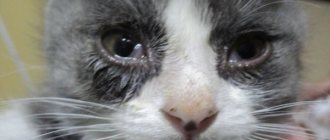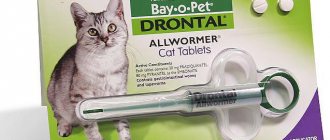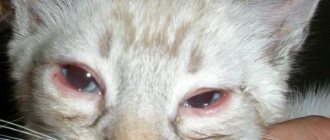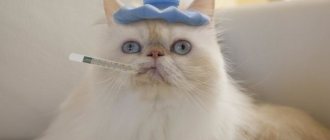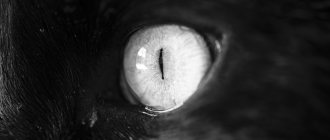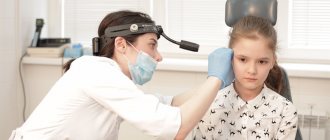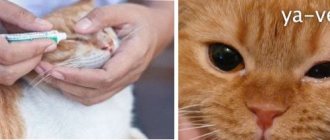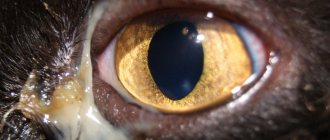Eyes are the mirror of the soul! We often say this phrase when talking about people. But, believe me, our four-legged pets also have very “talking eyes.” And since they cannot tell us about their feelings and desires in words, it is necessary to peer into these eyes more often. Remember, in them you will see love, devotion, and complete trust. They will tell you about the health status of your pet and will be able to warn you about possible problems. So, in this article we will find out why our pet’s eyes may become watery, what needs to be done in this case, and how to avoid possible diseases.
Tearfulness is a fairly common occurrence among our four-legged friends. This can be an indicator of a fairly serious disease, and sometimes it can only be the body’s reaction to debris or dust getting into the eyes. Another reason for severe tearing is dry air in the room. If it is not possible to increase the humidity, then it is necessary to instill in your pet’s eyes special moisturizers - “Artificial tears”, “Hypromellose”, “Dacrolux”. They have a lubricating and softening effect, protecting the eyes instead of tear fluid.
There are dog breeds that are prone to eye diseases, and for cats, the eyes are generally one of the most vulnerable organs.
Tears play a very important role - they cleanse and protect the eyes. They have an antibacterial effect and wash away all excess. Tear fluid is a natural protective reaction to various irritants, and therefore dogs and cats, like people, often have watery eyes, because this is the only way to moisturize their surface and get rid of any negative external factors. However, to begin with, it is worth noting that there are two main types of discharge from the eyes of an animal - mucous and purulent. To determine the disease, it is important to distinguish between them. Purulent discharge has a thicker consistency and a fairly rich greenish or yellowish tint. Oxidized tears are slightly brown or slightly reddish in color.
The animal's eyes are watery: reasons
Tearing can occur either from natural causes or as a result of illness.
In the first case, tears from the eyes may appear:
- After the furry animal woke up. This is a normal reaction of the body. The cat removes traces of tears itself by washing its face. For kittens, you can wash their eyesight with a swab moistened with boiled water.
- If the cat belongs to a certain breed. The Persian, the British, the Sphinx have tears and a peculiarity of the body. Persians are too fluffy, and doctors often diagnose the Sphynx breed with a disease called “entropion.” In this case, the animal can only be cured by resorting to surgery.
- If hair fibers get on the cornea. This symptom often occurs in long-haired small carnivores. The only thing that will help your cat is regular eye care.
In the second case, the cat may cry due to:
- Mechanical damage, injuries. A pet can damage the eyelid, eye, or cornea in a confrontation with another representative of its breed, during play or a walk. A sharp blade of grass or a twig that scratches the organ of vision can cause serious inflammation.
- Foreign objects. A small speck, a piece of tree bark, or a piece of plastic is enough to cause an inflammatory process to develop in a cat’s eye. Treatment in this case includes procedures for treating with solutions of antibacterial drugs.
- Burn. Curious animals often stick their noses into everything they find at home. Aggressive household chemicals, solvents, and wood varnish can become an object of curiosity, which will lead to a chemical burn. A pet can get a thermal burn if it becomes interested in cooking in the kitchen.
- Allergic reaction. Allergies are the scourge of the modern world; not only people, but also animals are susceptible to manifestations of allergies to various irritants.
- Incorrect eyelash growth. Sometimes a cat has a pathology - the eyelashes grow incorrectly, causing the pet a lot of suffering: the eyelid is inflamed, tears constantly ooze. In this case, the help of a veterinarian is required.
- Helminth infections. One of the signs of the disease is increased production of tears.
- Conjunctivitis. The infection is caused by chlamydia; only a veterinarian can cure the little predator.
- Colds. A cat often cries if it has a cold.
Be sure to read:
A cat sniffles through its nose: reasons, what to do when it is normal, sniffling is a sign of disease
How eyes are usually injured
When they talk about eye injury, they most often mean a violation of the integrity of the cornea, the upper transparent layer of the eyeball, under the influence of external factors. These include:
- getting a foreign object into the eye;
- a blow to the eye;
- wound;
- burn: chemical, solar and flame.
hit by a champagne cork, explosion of a firecracker - a very serious and, unfortunately, typical New Year's injury
In 90% of cases, patients present with microdamages and injuries to the eye with blunt objects, in 8% with burns, and in 2% with serious penetrating eye injuries.
Symptoms of eye injury
Not every person will immediately suspect corneal damage, mistaking it for a speck in the eye. As a rule, with strong blinking, tears wash away small debris. But if this trick doesn't help, you should worry.
In addition to discomfort, look for other symptoms of injury:
- lacrimation;
- feeling of “sand” in the eyes;
- high sensitivity to light;
- pain in the eyes, in rare cases - headache;
- uncontrolled contractions of the orbicularis eyelid muscles in response to painful sensations;
- redness of the eyes and eyelids;
- visible corneal defects.
If these symptoms appear, you should not hesitate to visit a doctor.
First aid for eye injury
The main rule when providing first aid is not to cause more harm. What you should not do if you have an eye injury:
- try to remove a foreign object from the eye yourself;
- rub your eyes;
- wash both eyes at the same time in case of chemical burns: this way the toxic solution gets into the healthy eye;
- try to “neutralize” the effect of an acid with an alkali (and vice versa);
- use cotton wool, as its fibers further injure the cornea.
How to help a person with an injured eye
First of all, you need to provide assistance only with clean hands to avoid infection. It is important to reassure the person and promptly deliver him to the eye trauma center of the Krasnoyarsk Regional Ophthalmological Hospital, which provides assistance to people with eye injuries around the clock. Address: Krasnoyarsk, st. Nikitina 1 V, phone 8
In case of eyelid injury, you should:
- treat eyelids with clean water;
- then cover the wound with a sterile gauze bandage; in case of severe bleeding, it is advisable to use a hemostatic sponge;
- Apply cold to reduce pain and prevent swelling.
If a speck hits:
- try to blink your eyes or wash the speck with water; You cannot remove dirt with a handkerchief, much less with sharp objects;
- apply antibacterial drops to prevent infection.
If the speck remains in the eye, stop trying to remove it on your own and refer the victim to an ophthalmologist.
For a chemical burn:
- rinse your eyes with running water at room temperature one at a time, tilting your head in the direction of the injured eye; Cleaning time for one eye is at least 20 minutes;
- If quicklime gets into your eye, first completely remove all crystals of the powder with a dry gauze cloth or bandage, and then rinse with water, otherwise a severe burn will occur.
- then you need to take the patient to the emergency room.
For eyelid burns with flame:
- remove contaminants and treat the skin with alcohol without affecting the mucous membrane and cornea;
- gently, without pressure, apply ice wrapped in a cloth or bag;
- Apply (if any) antibacterial ointment to the damaged skin and behind the eyelid.
After all the manipulations, the person must be taken to the hospital.
For ultraviolet burns:
- darken the room so that the light does not irritate the eyes;
- apply antibacterial ointment behind the eyelid;
- take painkillers;
- If the pain does not subside within a few hours, go to the emergency room.
A cat's eye is watering: what to do?
Excessive production of tears from one eye requires immediate action on the part of the owner:
- Assessment of general condition. It is necessary to conduct a visual inspection, measure body temperature, and examine the cat for injuries.
- Treatment of the affected eye with furatsilin (solution), decoctions of medicinal herbs.
- A trip to the veterinary clinic.
During treatment, a number of rules should be followed:
- Rinse both healthy and affected organs of vision.
- Remove the allergen from the home if an allergic reaction is diagnosed.
- When treating an infection, lubricate the eyes with ointments 2 times a day.
- If surgery is required, do not remove the special collar from the cat until complete healing.
How is eye injury treated?
Treatment is selected based on the type and extent of eye damage. In mild cases, we manage with drug therapy, which includes antibacterial drugs, non-steroidal anti-inflammatory drugs, painkillers and hormonal eye drops. For moderate and severe burns, the patient is hospitalized; for serious wounds, surgery is performed. Treatment after an eye injury involves using drops recommended by your doctor.
Consequences of eye injury
The consequences of damage depend on its extent and the quality of assistance provided. Doctors treat wounds and carry out all necessary manipulations, so if you quickly go to the emergency room, there will be fewer complications. Undesirable consequences are associated with infection entering the blood or even greater injury as a result of rash actions.
If a person does not receive timely medical care, scars remain, the soft tissues around the eye are deformed, and visual acuity decreases until it is completely lost.
If the infection enters the blood, sepsis develops - inflammation that is dangerous to the entire body. Accumulating pus affects the internal structures of the eye, sometimes reaching the brain, causing inflammatory processes in the body.
What can you do at home?
Get rid of drafts at home and make sure your cat doesn't get too cold. Check her diet. If necessary, consult a veterinarian and add a vitamin complex to its usual food so that the animal receives all the necessary nutrients. This will strengthen your immune system and improve your overall condition. Do not forget about regular prevention of parasites.
Do not wash your cat's eyes with a solution of potassium permanganate. Yes, it is known for its disinfecting properties, but at the same time it dries out the mucous membrane and can even burn it. In addition, if manganese crystals are poorly soluble in water and get into the eye, they can cause irreparable damage to vision.
Diagnosis of diseases
To identify diseases accompanied by irritation and redness of a cat’s eyes, an examination is used, including:
- Assessment of visual functions. Helps determine whether an animal’s vision is impaired or not.
- Appearance assessment. At this stage, signs of the disease are revealed - changes in the size and shape of the pupil, reduction of the palpebral fissure, redness and inflammation of the eyelids, traumatic changes.
- Identification of signs of damage to the eyeball. The size, shape, and presence of foreign bodies on the surface of the sclera are determined.
Prevention of eye diseases
Prevention of eye diseases in cats includes:
- Regular cleansing of the visual organs from natural secretions. Mucus that accumulates in the corners of the eyes becomes a good breeding ground for bacteria, which causes infectious conjunctivitis to develop.
- Avoid getting hair in the eyes. This problem affects long-haired animals. The hairs irritate the white of the eye, leaving scratches.
- Treatment of tear ducts. The area along the cat's nose is wiped with a cotton swab. This prevents the tear fluid from drying out.
- Proper implementation of hygiene procedures. When bathing an animal, do not allow detergents to get into the eyes. This also applies to insecticidal solutions used to treat cats against skin parasites at home. The products cause burns that contribute to redness of the eyes.
- Timely administration of vaccinations. Vaccination protects the animal from infections that cause eye diseases.
- Treatment of helminthic infestations. Parasitic worms produce toxins that can provoke negative reactions of the immune system, including allergic conjunctivitis.
The cat should be shown to the veterinarian at least once every six months.
All information posted on the site is provided in accordance with the User Agreement and is not a direct instruction to action. We strongly recommend that before using any product, you must obtain a face-to-face consultation at an accredited veterinary clinic.
How to treat your pet at home
Having discovered that the cat's eye is watering, they find out the cause of the problem.
But you should not self-medicate. The only thing the owner can do before going to the vet is to rinse the pet's eyes.
First aid for watery eyes
The washing procedure is rational in cases where a foreign body, an irritating substance has gotten under the cat’s eyelid, or the animal has been injured.
It is best to use saline solution (0.2% Furacilin) in this situation, but it may not always be at hand.
Therefore, prepare boiled water and proceed to the following actions:
the liquid is cooled;- moisten a cotton pad in water and apply it to the pet’s eye;
- wipe, moving from the inner corner to the outer.
If there is a lot of discharge, pus or blood is present, the discs are changed several times during the treatment process. In this case, new material is taken for the next eye.
To make the procedure more convenient, it is recommended to involve an assistant who will hold the resisting cat.
Professional diagnostics
Only a specialist can determine how serious the pathology is. At the veterinary clinic, a comprehensive examination of the animal is performed, all necessary tests are taken, as well as eye washes.
The results obtained are correlated with the owner’s story about how the disease developed, what symptoms accompanied tearfulness, and whether the pet’s behavior changed. This helps the doctor fully assess the situation and choose the right treatment.
Medications
All medications are prescribed based on the cause of lacrimation:
for conjunctivitis, Kanamycin, Levomycetin or Sofradex are recommended: the prescribed drug is instilled into the affected eye up to 5 times a day;- if the doctor prescribes antibiotics in the form of an ointment (Tetracycline is most often prescribed), then it is applied 3 times a day;
- if the eyelid and dermis near the eye are swollen, and the cat experiences severe pain, then it is prescribed hydrocortisone or novocaine.
Ophthalmological diseases require specific treatment, which is selected individually in each specific case.
Before removing the foreign body, the cat is given an anesthetic injection. Then, taking a cotton swab, roll the eyelid outward and try to remove the foreign object from the eye with tweezers.
Folk recipes
You can wash the eyes of sick cats using the same folk remedies as used in treating people. For excessive tearing, herbal decoctions (St. John's wort, calendula, chamomile, sage) help well. You can also make lotions with single-use black tea bags.
How to give first aid
If conjunctivitis is suspected, rinse the cat's eyes with furatsilin solution or use drops of levomecithin solution. An ointment containing antibiotics will help prevent infection and its consequences. Injections with painkillers like novocaine will relieve pain. If you have an allergy, find and eliminate the cause, and use an antihistamine.
But remember that self-medication can be ineffective and even dangerous. It is worth resorting to it only in cases where it is impossible to obtain qualified help. Make notes for your doctor to speed up diagnosis and improve accuracy.
- When and how lacrimation appeared, one or both eyes water;
- What does the discharge look like?
- Is the cat suffering from something chronic?
- When was the last time prevention of parasitic diseases was carried out;
- Has food or living conditions changed?
- Time of day when eyes water;
- Are there other deviations from the normal state?
Afterwards, the veterinarian will prescribe treatment. It is prohibited to change or refuse any medications without prior consultation, otherwise the treatment will be ineffective, and in other cases will give a negative result.
Eye diseases causing redness
The following diseases can contribute to the appearance of such a symptom:
- Blepharitis. The disease is accompanied by inflammation of the eyelid skin caused by bacteria or fungi. May occur due to an allergic reaction or injury. Blepharitis is accompanied by swelling and baldness of the eyelids, squinting, frequent blinking, itching, mucous or purulent discharge.
- Conjunctivitis. The disease is of viral or bacterial origin. In the latter case, the inflammatory process is characterized by an abrupt onset and rapid course. The clinical picture of viral conjunctivitis develops more slowly. In this case, purulent discharge does not always appear. Liquid mucus may be released from the conjunctival sac, which does not stick the eyelids together after sleep. This makes diagnosis very difficult. In the bacterial form of inflammation, thick purulent discharge sticks the eyelids together. The redness is mild.
- Glaucoma. The disease is characterized by an increase in intraocular pressure. It is diagnosed frequently. The sclera in cats turns red due to vasodilation. An enlarged pupil does not respond well to light. The cat tries to stay in dark rooms. The cornea and lens become cloudy, the eyeball enlarges. The appearance of red around the eyes of a cat is accompanied by swelling and incomplete closure of the eyelids. The animal experiences pain, orientation in space is disturbed, and the cat’s vision deteriorates.
- Entropion. The disease is characterized by inward turning of the eyelids. Eyelashes irritate the eye shell and injure it. Acute pain and lacrimation occur, the skin becomes red, the eye becomes red, and blepharospasm immediately appears - involuntary movement of the eyelids. If left untreated, the corneal tissue becomes inflamed.
- Entry of a foreign body. A grain of sand, wood shavings or splinter falls on the surface of the eyeball, injuring it. The animal's eyelids swell and turn red, the cat is in severe pain, and the pet does not allow its head to be touched.
- Uveitis. In the early stages, the symptoms of the disease are similar to those of conjunctivitis. The conjunctiva turns red, signs of irritation appear, and the pupil stops responding to light. Lacrimation is combined with the discharge of pus or mucus. A pink rim appears around the eyeball. White spots are found on the cornea, the color of the iris changes. The non-infectious form of the disease may be accompanied by allergic rhinitis.
